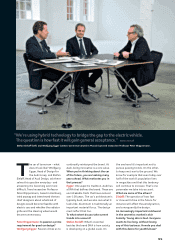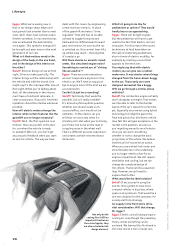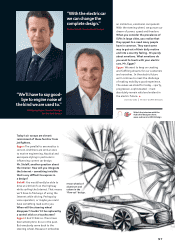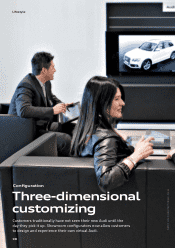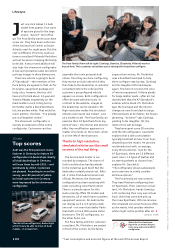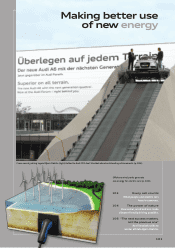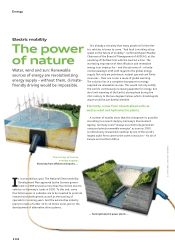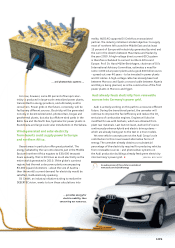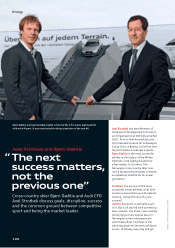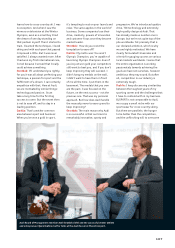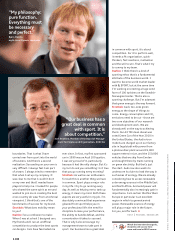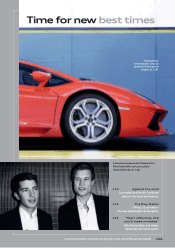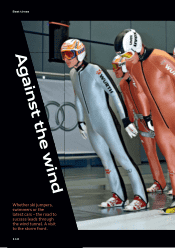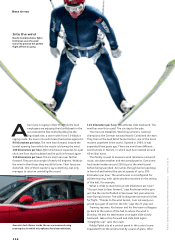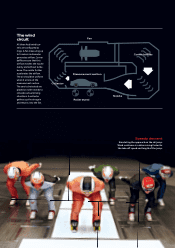Audi 2010 Annual Report Download - page 107
Download and view the complete annual report
Please find page 107 of the 2010 Audi annual report below. You can navigate through the pages in the report by either clicking on the pages listed below, or by using the keyword search tool below to find specific information within the annual report.
105
For now, however, some 80 percent of Europe’s elec-
tricity is produced in large-scale centralized power plants,
transmitted to energy providers, and ultimately sold to
consumers. Power grids in the future, conversely, will be
fed by very diff erent sources. Electricity will be generated
not only in decentralized wind, photovoltaic, biogas and
geothermal plants, but also by off shore wind parks in the
Baltic Sea and the North Sea, hydroelectric power plants in
Scandinavia and large-scale solar installations in the Sahara.
Desert areas in particular off er great potential. The
energy radiated by the sun onto deserts just in the Middle
East and northern Africa equates to 630,000 terawatt
hours annually. That is 30 times as much electricity as the
entire world generated in 2010. If the globe’s sunniest
regions had thermal solar power plants encompassing
83,000 square kilometers – about the size of Austria –
then the world’s current demand for electricity would be
satisfi ed, mathematically speaking.
Dii GmbH, an industry initiative striving to realize the
DESERTEC vision, wants to turn these calculations into
reality. AUDI AG supports Dii GmbH as an associated
partner. The industry initiative’s stated objective: to supply
most of northern Africa and the Middle East and at least
15 percent of Europe with electricity generated by wind and
the sun in the deserts between Mauritania and Sudan by
the year 2050. A high-voltage direct-current (DC) system
is therefore scheduled to connect northern Africa and
Europe. Prof. Dr. Hans Müller-Steinhagen, chairman of Dii’s
International Advisory Committee, estimates a need for
some 1,000 solar power plants and a good 400 billion euros
– spread out over 40 years – to be invested in power plants
and DC cables. A high-voltage cable has already been laid
between Morocco and Spain; a second cable between Algeria
and Italy is being planned, as is the construction of the fi rst
power plants in Morocco and Egypt.
Audi is actively working on this path to a resource-effi cient
future. During the transitional period, the carmaker will
continue to improve the fuel effi ciency and reduce the CO2
emissions of combustion engines. Engines will also be
modifi ed for use with biofuels, which are obtained from
plant raw materials. Last but not least, Audi will of course
continuously enhance hybrid and electric drive systems –
which are already being put to the test in e-tron models.
Yet new vehicle concepts are not the Audi Group’s sole
contribution to this move toward alternative forms of
energy. The carmaker already obtains a a substantial
percentage of the electricity required for producing vehicles
from renewable sources – and photovoltaic systems on
the Audi production buildings already feed green electricity
into Germany’s power grid.
O
JÜRGEN BISCHOFF
... and photovoltaic systems ...
... provides energy for
electric mobility, thus
conserving our resources.
Wind-generated and solar electricity
from deserts could supply power to Europe
and northern Africa.
Audi already feeds electricity from renewable
sources into Germany’s power grid.
An audio version of this article is available at
www.audi.com/ar2010/energy


